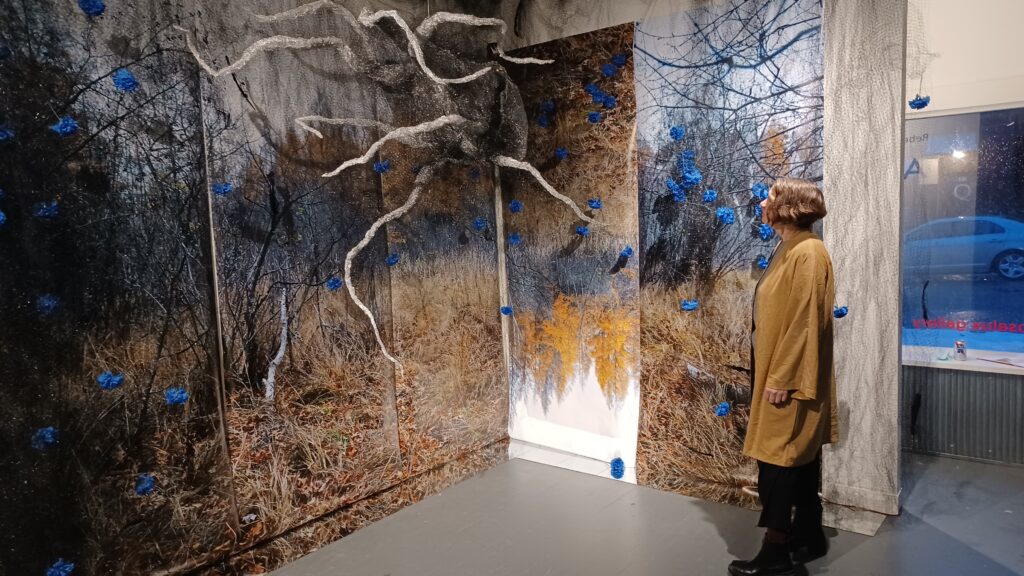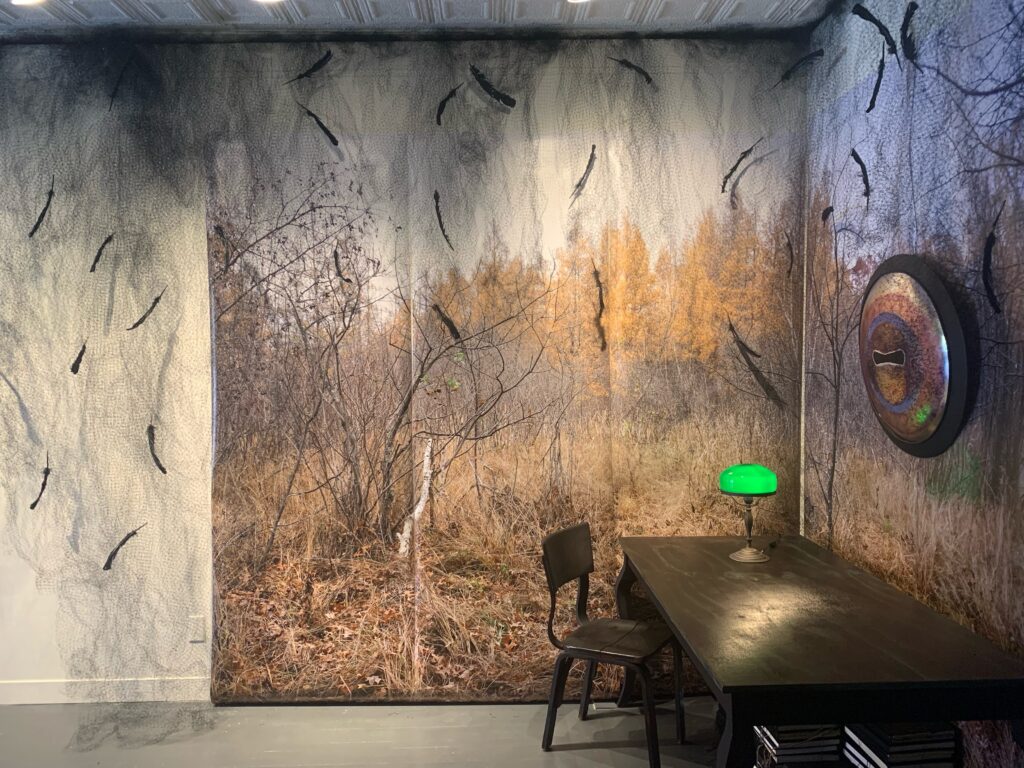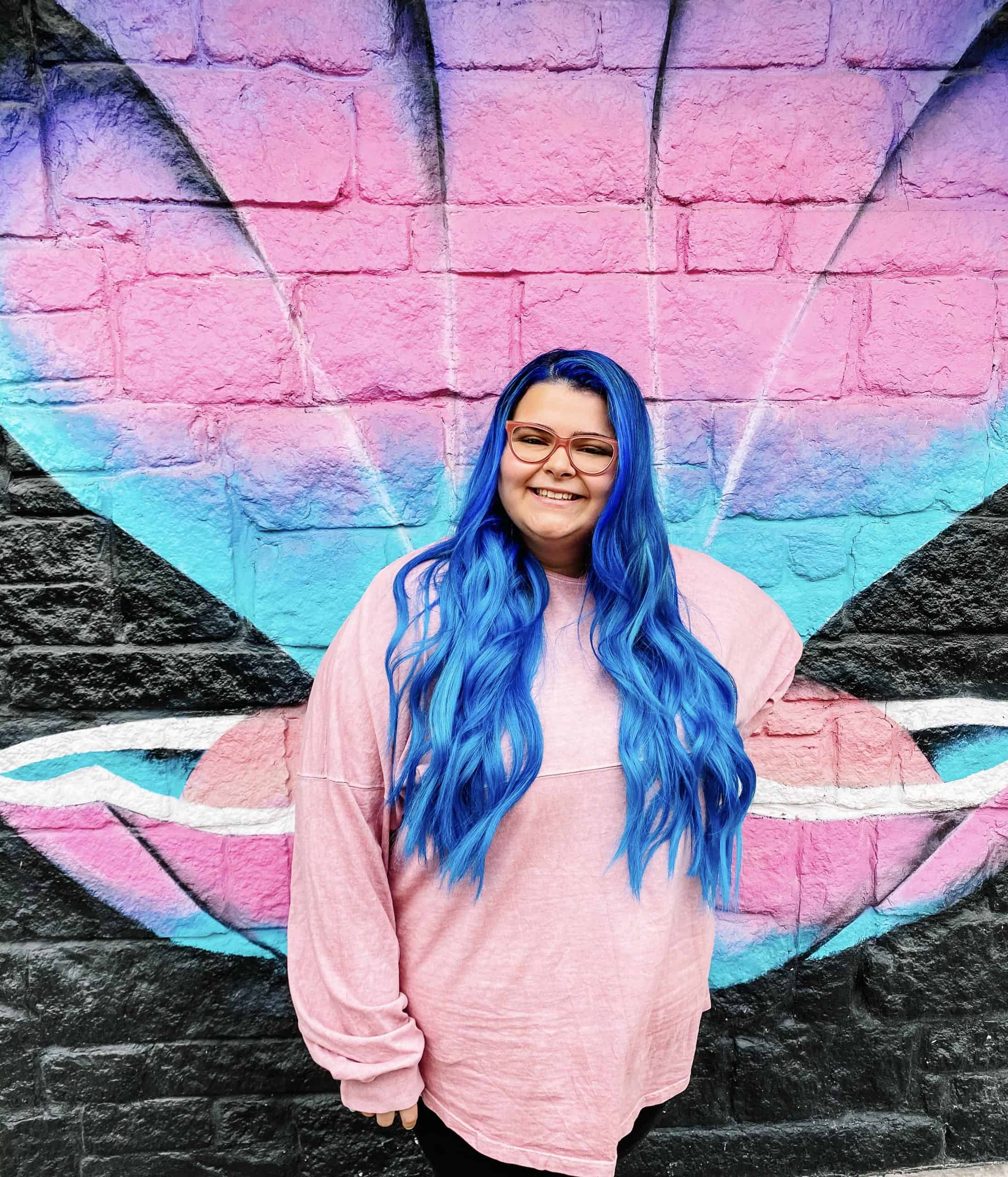‘Artist Spotlight’ Of The Week: Rebecca Krinke
Howdy Nation! In today’s post, we are going to be featuring our ‘Artist Spotlight’ of the week: Rebecca Krinke. As an artist and a Landscape Architecture professor at the University of Minnesota, her art-design practice and research are all related to exploring the wonder, terror, and mysteries of our times. Let’s take a closer look at Rebecca’s art exhibitions showcasing the octopus!

Meet Rebecca Krinke!
I’m so excited to introduce Rebecca and showcase her talents in our “Artist Spotlight” series.
The work we are showcasing today is from her last two art exhibitions. They are both examples of installation art, meaning the entire created environment that you are seeing is the artwork – and it includes objects she has made as well as objects that she altered.
Believe it or not, Rebecca made the octopus from metal mesh and netting, AND she personally painted the large octopus eye.
We are completely obcephed!
Tell us more about your octopus art exhibitions!
“As far as the overall ideas of the installations, I’ll describe the “Submerged” installation (January-February 2022) first.”
“Submerged”
“There is an uncanny library set within the liminal space of a tamarack bog (via a photograph I took and printed in large sheets).
A mirrored octopus eye hovers above a writing desk and a dream octopus seemingly emerges through the windows in a cloud of black smoke-ink (the netting).
Atop the long library table, there is a series of sculptural books I made called “The Library of Touch”. There are no words in these books; they each embody the texture, skin, or surface from my previous bodies of work.
In “Submerged”, the created room evokes a space where intuition, feeling, and dreaming are brought forth as powerful ways of learning and knowing what cannot be said in words.”

“Anomaly”
The second installation, “Anomaly” of March 2022, created a mysterious space for contemplation.
Here, components of “Submerged” were adapted, reconfigured, and added to. “Anomaly” honors my two parent spaces – the outdoor world and the library – for teaching me in profound ways not readily seen by or shared with others.
The green velvet curtains wrap the the visitor on all sides and thicken with black feathers, blue flowers, and netting. The bog appears in two of the long narrow room’s corners:
– One for the uncanny study with octopus eye again hovering
– In the other corner the octopus itself emerges as if from the bog, another dimension, or dream state.The octopus has gotten closer and more involved with the interior space and the viewer. The gap/relationship between inside and outside takes center stage and heightens anomalous sensations as it calls upon the aquatic, the terrestrial, and the human-made.”

What draws you in or fascinates you the most about octopuses? When did this start for you?
“As a child, I fell in love with Jules Verne’s “Twenty Thousand Leagues Under the Sea.”
Exploring the ocean depths in a strange and luxurious submarine seemed like a dream come true – yet there were also some deep mysteries and beings outside (and inside) the submarine. Ever since, I have been fascinated by the idea of exploring , secrets, and the underwater realm (among many other things).
About three years ago, maybe a little more, I had a very potent dream about an octopus. I know it was before the Netflix series “The OA” aired their episode with the octopus. My dream octopus felt alluring and threatening, as if I was being given an invitation to go deeper into the primordial and their alien-but not alien-world!
This disturbed me but I knew I had no choice. I began to research everything I could about the octopus. Everything from nonfiction to fiction and looked deeply at images while watching endless amounts of videos. I fell in love with their strange and wondrous abilities to transform and regenerate; to change the color and texture of their skin; and their ink clouds of escape.
They are prey AND predator!”

OctoNation members love knowing how long your work takes you to complete… Can you describe the process?
“My process of making art is ever in flux, since I don’t make repeatable objects – I am making whole worlds through my chosen vehicle of installation art.
So while you see my octopus sculpture and octopus eye sculpture appear in both installations, they do not appear in the exact same way!
In my studio, I can only mock up portions of my installation ideas. I keep in mind the specifics of the spaces I will be showing in, but until I get in the gallery itself, I don’t know what it will look like.
So while it is an intense “high wire act” to create a site-specific installation in a few days, it is also exhilarating to make something that no one, including me, has never seen before.”

Was this modeled after a specific octopus species? Did you use any references?
“I did use references to make the octopus sculpture and paint the large octopus eye, primarily photos and videos. I often looked at the Common Octopus and the Giant Pacific Octopus.
OctoNation was a big part of this research!”

What materials were used?
“The octopus is made of metal mesh and black bird netting – and I painted small spheres for the eyes. The bird netting also alludes to the black ink the octopus can release at will.
The large octopus eye is painted on a convex mirror – and the layers of glazed paint on the mirror create a shimmering effect and reflective depth as you move around the eye.”

Who (or what) are your biggest influences?
“I love the work of the artists Louise Bourgeois and Walter De Maria! Louise worked with themes of trauma and Walter with transcendence. There are many other artists, writers, thinkers, and makers, but the my deepest inspiration is being alive on this wondrous planet.”

When do you feel the most creative?
“I normally am very creative in the evening.”

How do you know when a piece is finished?
“When nothing needs to be added and nothing needs to be taken away… that’s when I take a step back.”
What’s the best website for people to discover your work?
“You can stay update to date with my latest art exhibitions on my website, rebeccakrinke.com!”
🐙 Octopus Fun Fact
“Next, I plan on exploring and painting more octopus eyes on convex mirrors and working with the colors and patterns of octopus skin to make a kind of new fabric that will drape and float and surround a whole room and the viewer. There will also be many painted octopus eyes.
This “Octopus Dream Room” is my new dream!”

Thank You For Joining Us For Artist Spotlight!
First, we want to give a big thank you to Rebecca for allowing us to showcase both of her art exhibitions on OctoNation. To continue supporting Rebecca and her art, make sure to follow them on Instagram @rebeccakrinke. If you are interested in commissioning a piece from them, reach out to her via Instagram.
If you want to educate yourself some more about all sorts of different cephalopods, take a look at our encyclopedia. Or, what we call it, our Octopedia!
Connect with other octopus lovers via the OctoNation Facebook group, OctopusFanClub.com! Make sure to follow us on Facebook and Instagram to keep up to date with the conservation, education, and ongoing research of cephalopods.
More Posts To Read:
- Do Octopus Bite?
- Does Octlantis Exist?
- “How The Octopus Lost Its Shell” (Octopus Comic)
- What’s The Difference Between Cuttlefish vs. Octopus?
- Breaking News – There are now THREE new species of Nautilus!

Vee is the blog manager here at OctoNation. Her love and knowledge for all things cephalopods has grown immensely since joining the OctoNation team- and continues to grow daily!
Vee uses her skills of writing, editing, and brainstorming to help create fun, yet educational posts about cephalopods- Something everyone can read and enjoy! As someone who spent the better part of her childhood near the ocean in Miami, Florida, she grew up learning to appreciate all sea life. Her love for the sea inspired her to do something daring- she dyed her hair blue!






